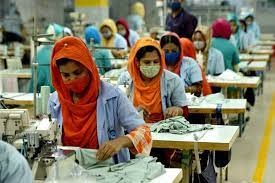Key Challenges in Accessing Schemes by Garment Sector Workers
Less estimation of garment workers:
- CIVIDEP, one of our partner organizations, highlights the issue of underrepresentation of garment sector workers in the broader workers' database. Official government records suggest 90,000 workers in the sector, but the reality is that there are over 1,500 factories in the sector employing at least 5,000 garment workers. In Bangalore alone, there are approximately 4 lakh garment sector workers, with 85% of them being women. This underrepresentation poses challenges, potentially resulting in fewer accessible schemes and a lack of advocacy for the rights and welfare of these workers.
Identity of garment sector workers:
- Unlike workers in sectors such as construction, those in the garment industry lack a clear employee identity. Despite being registered with the Employees' Provident Fund Organization and the Employees' State Insurance Corporation, their formal classification does not correspond with the notably low salaries or wages they receive as formal sector workers. The minimum salary remains at Rs. 10,330 per month, and even after 10-15 years of experience, it remains stagnant at this level.
please check this does it make sense
Unpaid Overtime and High Production Pressure:
- Garment industry workers typically endure an 8-hour shift, but the challenges extend beyond the standard workday. The demand for meeting production targets often leads to unpaid overtime work, with employees compelled to rectify 'mistakes' in the manufacturing process. This expectation of extended working hours not only places a burden on the physical well-being of the workers but also contributes to heightened levels of fatigue and stress. Additionally, the emphasis on meeting production quotas can foster a high-pressure work environment, impacting the overall cohesion among workers. This creates a challenging dynamic where individuals are pushed to work beyond regular hours without adequate compensation, affecting both their personal lives and job satisfaction.
Duality in Formal Classification: Informality Challenges Faced by Garment Sector Workers
While garment sector workers are officially classified as part of the "Formal Sector," their working conditions and practices often mirror those found in the informal sector. Despite the formal classification, several aspects contribute to the similarity with the informal sector:
- Low Wages: Garment sector workers, despite being in the formal sector, frequently face low wages that may not align with the industry's demands and the cost of living.
- Job Insecurity: Contractual employment is prevalent, leading to job insecurity. Workers may not have long-term job stability, and layoffs or terminations can occur without proper job protection.
- Lack of Unionization: In many cases, garment sector workers lack strong unions within the factories. This absence of collective bargaining power limits their ability to advocate for improved working conditions and rights.
- Exploitative Practices: Instances of verbal and physical abuse, exploitative work practices, and inadequate safety measures are reported, reflecting conditions often associated with the informal sector.
- Limited Social Security Benefits: Access to social security benefits, such as health insurance, provident funds, and other formal employment perks, may be restricted or insufficient for many workers.
- Informal Work Arrangements: Some garment workers face informal work arrangements, where verbal agreements and understanding rather than written contracts dictate terms of employment.
In essence, despite the formal classification, the challenges and practices experienced by garment sector workers often align more closely with those in the informal sector. This duality reflects the complexities and shortcomings within the formalization of certain industries

